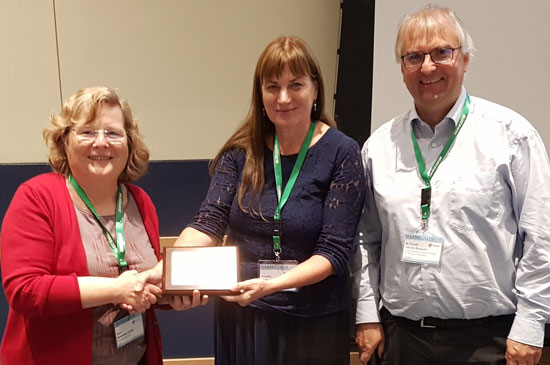
Mathematical geosciences conference focuses on food, energy, water nexus.
Image: Katherine Silversides
More than 175 researchers, students, and industry professionals from companies and universities around the world gathered on Penn State’s University Park campus from August 10-15 for IAMG 2019, the twentieth annual conference of the International Association for Mathematical Geosciences (IAMG).
“It was indeed a privilege to have such an august assembly of scholars from all parts of the world and hear them engage in topics of profound importance to all of us, ranging from modeling of ocean margins; climate modeling; modeling complex coupled processes at the intersection of food, water, and energy; as well as modeling of complex hydrocarbon and mining resources,” said Sanjay Srinivasan, head of the John and Willie Leone Family Department of Energy and Mineral Engineering, affiliate at the EMS Energy Institute and conference chair. “Penn State was well represented by researchers from energy and mineral engineering, geosciences, geography, meteorology, mathematics, agricultural sciences, and statistics.”

Matheron Lecturer Vera Pawlowsky-Glahn with Jenny McKinley and K. Gerald van den Boogaart
Image: Katherine Silversides
The aim of the conference was to promote worldwide advancement of mathematics statistics and informatics in the geosciences. Short courses, plenary speakers, oral and poster presentations, and social events promoted discussions around geomodeling issues at the intersection of food, water, and energy. Along with attendees from thirty countries, this year’s conference hosted more female researchers and Ph.D. candidates than in previous years.
Pre-conference activities included short courses on machine learning for geoscience modeling and geological applications of compositional data analysis. The courses were taught by faculty members from U.S. and international universities, including the University of Texas at El Paso, and a scientist from the U.S. Geological Survey.
Sessions comprised of both oral and poster presentations covered a range of issues from mining modeling to marine geosciences to atmospheric and earth system science.
“I was particularly impressed by the emphasis on developing early career researchers and the strong collaboration with our global sponsors—both of which will advance excellence in partnerships working across the mathematical geoscience community,” said Jennifer McKinley, IAMG president and a professor at Queen's University in Belfast, UK.
A keynote address from Lee Kump, John Leone Dean in the College of Earth and Mineral Sciences, titled “Simple Models for Complex Problems” drew on his work as an Earth historian in discussing how straightforward and complicated models can, or cannot, address relatively simple problems.

Delegates from some of the sponsoring institutions with Jenny McKinley and Sanjay Srinivasan Image: Katherine Silversides
Seven other keynote speakers discussed opportunities for growth within the geoscience field including:
- "Deep-time Digital Earth (DDE) Big Science Program: Opportunity for Mathematical and Data Geosciences”—Qiuming Cheng, International Union of Geological Sciences, Canada
- “Karst Aquifer Modeling, State of the Art and Challenges”—Philippe Renard, University of Neuchatel, Switzerland
- “Object Oriented Spatial Statistics: An Approach to the Analysis of Georeferenced Complex Data”—Alessandra Menafogilo, Department of Mathematics, Politecnico di Milano, Italy
- “Geo-Information Extraction and Integration in Support of Mineral Exploration”—Wenlei Wang, Institute of Geomechanics, Chinese Academy of Geological Sciences, China
- “Driving Transformations in the Energy Industry: Convergence of Emerging Technologies with Mathematical Geoscience”—Susan M. Agar, Aramco Global Research Center, U.S.
- “Outliers and Compositional Data”—Peter Filzmoser, Institute of Statistics and Mathematical Methods in Economics, Vienna University of Technology, Austria
- “Compositional Data in Geostatistics: A Log-Ratio Based Framework to Analyze Regionalized Compositions”—Vera Pawlowsky-Glahn, University of Girona, Spain
This was only the second time the annual, international conference had been hosted in the U.S.
“The IAMG conference returned to the U.S. ten years after the meeting at Stanford,” Srinivasan said. “It was an honor afforded to Penn State and a testimony to the excellent infrastructure available within the University and the breadth of research conducted across the University.”
Conference partners included Aramco, Chevron, Schlumberger, and the Central Pennsylvania Convention and Visitors Bureau along with University support from the Institute for Computational and Data Sciences. The conference was organized and hosted by the College of Earth and Mineral Sciences and the EMS Energy Institute.
About IAMG
IAMG is a nonprofit organization promoting international cooperation in the application and use of mathematics in geological research and technology through meetings and publications. Next year’s conference will be held in India. To learn more about IAMG, visit the organization’s website at iamg.org.

